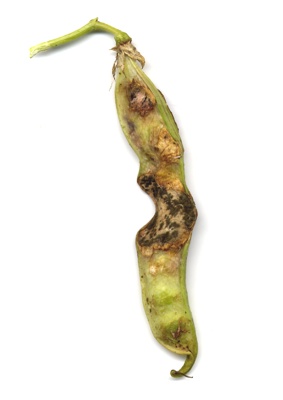Diseases
Alternaria alternata (Fr.) Keissl. - Alternaria Stem Spot of Peas
Systematic position.
Class Deuteromycota, group of orders Hyphomycetales, order Dematiales, family Dematiaceae, genus Alternaria.Synonym.
Alternaria tenuis Ness.Biological group.
This species is a saprobiont.Morphology and biology.
Seeds and infected vegetation residues are sources of the infection. The fungus A. alternata proves itself more often as a saprophyte, developing on mortified vegetation, forming a velvety olive bloom. Harmful activity of the fungus causes reduction of germinating capacity of pea seeds. Parasitic ability is usually evident on weakened or injured plants. On affected parts it forms mycelial bloom. The fungus A. alternata forms olive or black-brown obclavate conidia that have 3-6 transversal, and one longitudinal, septa, with strangulations and arranged in easily breaking chains, 30-50 x 14-18 microns in size. The fungus spreads during the vegetation period by conidia.Distribution.
This species is cosmopolitan. In Russia and countries of the former USSR the area of distribution of the fungus coincides with areas of cultivation of peas.Ecology.
Optimum air temperature for the pathogen development is 20-25.C, and optimum relative air humidity is 70-90%.Economic significance.
The fungus affects a large number of plants from various families. It does not essentially cause harm to peas. However, it reduces the germinating capacity of seeds. Control measures include seed dressing, maintenance of storage conditions for sowing material, destruction of vegetation residues.Reference citations:
Khokhraykov M.N., Dobrozrakova T.L., Stepanov K.M., Letova M.F. 1966. Keys to plant diseases. Leningrad: Kolos. 592 p. (In Russian)Pidoplichko N.M. 1977. Fungal parasites of cultural plants. Guide, Vol. 2. Kiev: Naukova Dumka. 299 p. (In Russian)
© Kungurtseva O.V.


